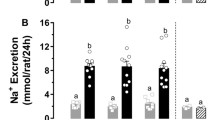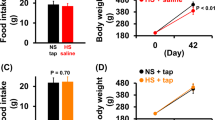Summary
In male Sprague-Dawley rats the left renal artery was constricted by a 0.2 mm silver clip while the contralateral kidney was left untouched. 10 days after clipping the animals were offered, in addition to water, 0.9% saline as drinking fluid for 6 days. Hypertensive animals drank twice as much saline as did control rats throughout the period of observation. In the hypertensive animals, 24-hrs saline intake during the first day of the self-selection study was quantitatively related to the actual height of blood pressure and to the preceding blood pressure increase. After 6 days on the self-selection regimen, plasma angiotensin II concentrations in the hypertensive rats were elevated by 50% when compared with control rats.
On the basis of these and previously reported findings (i.e. an increased activity of the renin-angiotensin-aldosterone system and sodium retention) it is suggested: a) despite sodium retention salt appetite is enhanced, indicating a disordered regulation of sodium balance during the early phase of renal hypertension in rats; b) elevated plasma concentrations of angiotensin II and aldosterone could have enhanced salt appetite; c) despite greater salt intake than in control rats the activity of the renin-angiotensin system remains elevated in renal hypertensive rats, thereby possibly inducing a sustained high saline intake.
Similar content being viewed by others
References
Byrom, F. B., Wilson, C.: Plethysmographic method for measuring systolic blood pressure in the intact rat. J. Physiol. (Lond.)93, 301 (1938)
Denton, D. A.: Salt appetite. In: Handbook of Physiology, Neurophysiology, Alimentary Canal, p. 433. Ed. by J. Field, H. W. Magnon and V. E. Hall. Washington, D. C.: Amer. Physiol. Soc. 1967
Dietz, R., Mast, G. J., Möhring, J., Vecsei, P., Gless, K. H., Oster, P., Gross, F.: Aldosterone and corticosterone production in renal hypertensive rats. Acta endocr. (Kbh.) (in press.)
Gross, F.: Adrenocortical function and renal pressor mechanisms in experimental hypertension. In: Essential Hypertension, p. 92. Ed. by K. D. Bock and P. T. Cottier. Berlin-Göttingen-Heidelberg: Springer 1960
Gross, F., Möhring, J.: Renal pharmacology, with special emphasis on aldosterone and angiotensin. Ann. Rev. Pharmacol.13, 57 (1973)
Johnston, C. I., Kaiser, P., Gross, F.: Influence of adrenalectomy and ureteral ligation on the pathogenesis of renal artery constriction. J. Lab. Clin. Med.71, 1013 (1968)
Laragh, J. H., Sealey, J. E.: The renin-angiotensin-aldosterone hormonal system and regulation of sodium, potassium, and blood pressure homeostasis. In: Handbook of Physiology, Renal Physiology, p. 831. Ed. by J. Orloff and R. W. Berliner. Washington, D. C.: Amer. Physiol. Soc. 1973
Miksche, L., Miksche, U., Gross, F.: Effect of sodium restriction on renal hypertension and on renin activity in the rat. Circulat. Res.27, 973 (1970)
Möhring, J., Möhring, B., Haack, D., Lazar, J., Oster, P., Schömig, A., Gross, F.: Thirst and salt appetite in experimental renal hypertension of rats. In: Control Mechanisms of Drinking, p. 155. Ed. by J. Fitzsimons, L. Peters-Haefeli and G. Peters. Berlin-Heidelberg-New York: Springer 1974
Möhring, J., Möhring, B., Näumann, H.-J., Philippi, A., Homsy, E., Orth, H., Dauda, G., Kazda, S., Gross, F.: Salt and water balance, and renin activity in renal hypertension of rats. Amer. J. Physiol. (in press)
Oster, P., Hepp, R., Hackenthal, E.: Radioimmunoassay of angiotensin II in rat plasma. Experientia (Basel)29, 353 (1973)
Renkin, E. M., Gilmore, J. P.: Glomerular filtration. In: Handbook of Physiology, Renal Physiology, p. 185. Ed. by J. Orloff and R. W. Berliner. Washington, D.C.: Am. Physiol. Soc. 1973
Severs, W. B., Daniels-Severs, A. E.: Effects of angiotensin on the central nervous system. Pharmacol. Rev.25, 415 (1973)
Weisinger, R. S., Woods, S. C.: Aldosterone-elicited sodium appetite. Endocrinology89, 538 (1971)
Wolf, G., Handal, P. J.: Aldosterone-induced sodium appetite: dose-response and specifity. Endocrinology78, 1120 (1966)
Wolf, G., McGovern, J. F., Dicara, L. V.: Sodium appetite: some conceptual and methodologic aspects of a model drive system. Behav. Biol.10, 27 (1974)
Wong, R., Whiteside, C. B. C.: Sodium preference induced by angiotensin in the rat. Pharmacol. Res. Commun.6, 307 (1974)
Author information
Authors and Affiliations
Rights and permissions
About this article
Cite this article
Möhring, J., Petri, M. & Möhring, B. Salt appetite during the early phase of renal hypertension in rats. Pflugers Arch. 356, 153–158 (1975). https://doi.org/10.1007/BF00584294
Received:
Issue Date:
DOI: https://doi.org/10.1007/BF00584294




